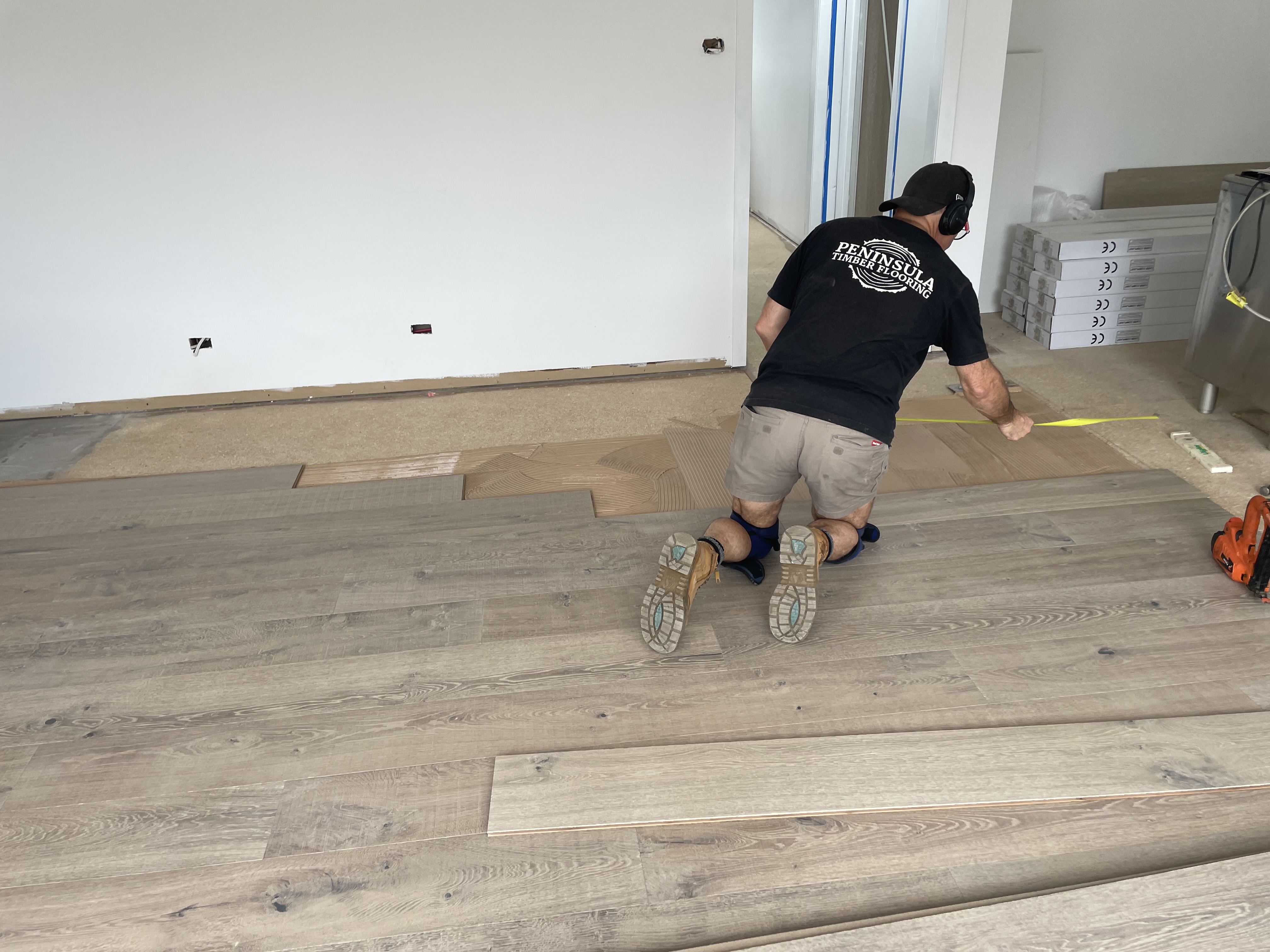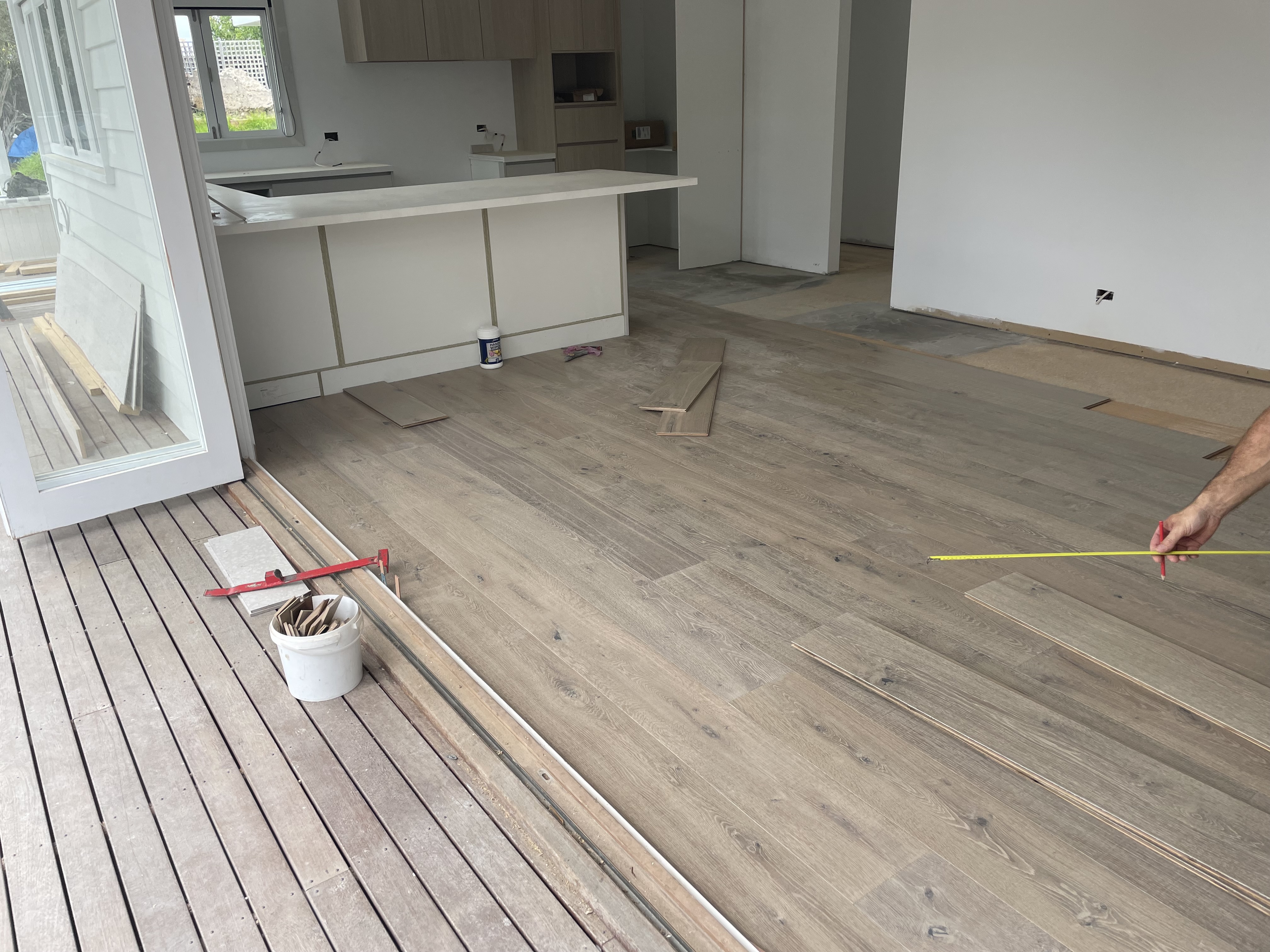Hughes Rd: Custom Home Builders Mornington Peninsula
Timber Flooring Installation
After detailed consultation and site assessment, the client selected a pre-finished engineered timber product, an ideal solution for its visual appeal, durability, and stable performance over time. Now, our team is focused on precise installation to meet the client’s vision of a warm, modern, and resilient timber floor finish.
%20(1).jpg)
Flooring Options: Why Engineered Timber?
When installing flooring, our main job is to ensure our client’s flooring choice will perform, endure, and add value to the space. That means weighing aesthetics against practical realities, including moisture levels, foot traffic, installation method, budget, and how the flooring will age over time.
Here’s a closer look at the most commonly considered timber and timber-look flooring options:
Solid timber flooring
Solid timber is a traditional, high-end flooring choice made from a single species of hardwood, such as Blackbutt, Spotted Gum, or Oak. Its full-thickness structure allows it to be sanded and polished multiple times across its lifespan, making it ideal for homes that want a long-term investment with timeless character.
Pros:
- Authentic and tactile
- Can be sanded and re-coated multiple times (often over 4–5 cycles)
- Ages beautifully if maintained
- Increases property value in high-end markets
Cons:
- Susceptible to expansion and contraction and may cup, warp, or shrink if not installed in a controlled environment
- Requires professional sanding and polishing after installation
- Installation costs are higher due to labour and acclimatisation requirements
- Needs more maintenance to preserve surface quality
Engineered timber flooring
For the Hughes Rd project, the client chose engineered timber flooring, and with good reason. This flooring type is a smart, performance-driven choice that suits modern Australian homes where temperature fluctuations and slab-based construction are common.
It delivers the timeless beauty of hardwood while offering improved structural stability, reduced maintenance, and faster installation. Its layered core also reduces movement, making the boards less prone to warping, cupping, or gapping compared to solid timber.
Pros:
- Genuine timber surface
- Pre-finished boards save time, mess, and drying delays
- Suitable for both floating and direct stick installs
- More dimensionally stable than solid timber
Cons:
- Limited sanding potential. You can typically perform 1–2 refinishes, depending on veneer thickness
- Slightly less prestige compared to full hardwood for purists
- Quality varies greatly. Those with thinner veneers and poor cores can reduce lifespan


Vinyl plank flooring
Vinyl planks are a fully synthetic product, typically made from multiple layers of PVC with a photographic timber pattern and a protective wear layer. It’s a tough, versatile option often used in commercial or high-wear areas.
Pros:
- 100% water-resistant, making it ideal for bathrooms, kitchens, and basements
- Highly durable and stain-resistant
- Budget-friendly and fast to install
- Quiet and soft underfoot with correct underlay
Cons:
- Doesn’t replicate the natural grain or texture of wood, so it feels plasticky underfoot
- Can fade with prolonged UV exposure
- Cannot be refinished or repaired. Damaged planks must be replaced
Hybrid flooring
Hybrid floors combine the core strength of laminate with the water resistance of vinyl. They’re typically built with a rigid limestone composite or polymer core, allowing their boards to be completely waterproof while maintaining the look of timber.
Pros:
- Fully waterproof and can be installed in bathrooms and laundries
- Extremely stable and resistant to movement
- Easy to clean, scratch-resistant, and UV-stable
- Click-lock installation allows quick and seamless laying
Cons:
- Has a harder, less forgiving feel underfoot compared to timber
- Cannot be sanded or resurfaced
- It may sound hollow if installed without an acoustic underlay
Laminate flooring
Laminate flooring uses a printed image of timber beneath a tough wear layer. Though it doesn’t contain any real wood, advances in design have made higher-end laminates convincingly realistic.
Pros:
- Affordable and widely available
- Highly resistant to scratching and dents
- Comes in a range of textures, colours, and board widths
- Easy to replace individual planks in floating systems
Cons:
- No natural timber grain or warmth, only a printed layer
- Not water-resistant unless specifically rated as waterproof
- Can’t be sanded or repaired. When damaged, it must be replaced
Our Direct Stick Installation Process
For the Hughes Rd. project, we used the direct stick method to install the engineered timber flooring. Compared to floating systems, this approach delivers a more solid, authentic feel underfoot.
Precision was key at every stage. We began with moisture testing and surface preparation to ensure the subfloor met the strict flatness and dryness requirements of the material. Once primed, each board was laid with care using a flexible adhesive. It was also aligned with attention to grain, pattern, and balance to achieve a seamless, high-performance finish.
When helping clients choose the right flooring, we primarily consider how they’ll perform in real homes. And while we offer hardwood floors in our projects, we tend to gravitate towards other alternatives due to cost factors and movement in the natural timber.
Among these alternatives, engineered timber continues to stand out for its reliability and performance. It offers the natural warmth of hardwood with less risk of movement, especially in areas with temperature fluctuations or direct sunlight. It also strikes a balance between visual appeal and budget, making it ideal for modern builds on concrete slabs.
For homes with pets, pools, or heavy traffic, we may recommend vinyl or hybrid alternatives for their durability and moisture resistance.
Ultimately, our goal is to guide each client toward a flooring option that aligns with their lifestyle, aesthetic preferences, and environmental conditions, while ensuring every installation is executed with absolute precision.
Start your Project with Temsea
.webp)